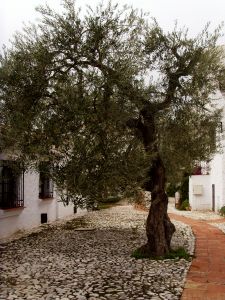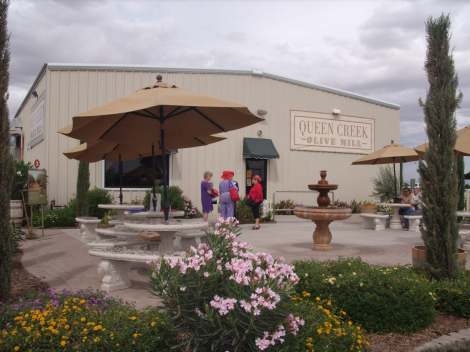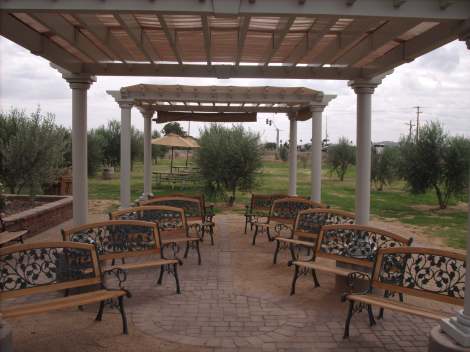This site has been officially moved to a new domain, http://www.myhalalkitchen.com. Please visit there to see what’s cooking!
Last October I visited the Queen Creek Olive Mill just outside of Scottsdale, Arizona. I never knew this region could cultivate olives until I heard about the mill from a relative who lives nearby. After doing a bit of research on the place, I just had to see it before heading back to the Midwest. We sure can’t grow olives in Chicago!

Copyright 2008-2009 My Halal Kitchen
I’ve always been interested to know how any type of Mediterranean food grows. I suppose I feel the need to learn so that one day I might be able to grow any number of them myself: olives, pomegranetes, lemons, dates, apricots, almonds. I’d probably need an orchard first, though. Right?
I really feel bad that for the number of times I’ve visited Sicily, I’ve never really gone to the olive groves to learn more about from where some of the best olive oil in the world really comes. I enjoyed eating- a lot– in Sicily, yet never really bothered to venture further than the wonderful jovedi (large Thursday market) where I could delight in the colorful produce and fresh, exotic Mediterranean seafood. There, things like olives and cheeses were very expensive, yet tempting enough to buy just a handful and be comforted to know that this land of olives would forever supply us with them.
Needless to say, upon hearing about the Queen Creek Olive Mill, I was instantly interested in going there to see first-hand just how and when olives are hand picked and perfectly pressed to make the purest olive oil one can find in the U.S. Who would have known that in this little Arizona town one could grow olives when conventional thinking would lead you to believe that California is the only American place cultivating these precious trees?

Upon arrival, we decided to take the $5 tour of the mill where we would learn all about the process of olive cultivation, picking and pressing. We were first escorted out onto the terrace where a young employee of the company explained to us the very basics of how the Queen Creek Olive Mill was started and about the unique temperature here that makes it possible for these olives trees to flourish.
The business of producing olive oil for sale started just over five years ago here at the base of the San Tan Mountains, an area known for its fertile soil. In this micro-climate, the olive trees will amazingly not experience any mold or fermentation.
Harvesting goes from mid-October to mid-December, so our visit was just two weeks shy of the olive picking season. During the season, olives are harvested at this pesticide-free grove daily by raking and combing them off the trees. Fallen olives are never used because they are considered to be either over-ripe or invaded by pests.
Each olive tree will give anywhere between 50-200 lbs. of olives. One ton of olives will go on to produce 55 gallons of the extra virgin olive oil. Queen Creek’s trees include a variety of Italian, Spanish and Greek ones such as the Mission, Manzanillo, Sevillano, Pendolino, Grappolo, Lucca, Frantoio and the Kalamata.

Olive Fruit on the Tree
During the harvesting season Queen Creek bottles their olive oil every three weeks and blends their oils every three to five weeks. Their base oil produced from these trees is made of a Tuscan style blend, from which they make some very interesting flavored and cold pressed oils (Meyer Lemon and Blood Orange were two of my favorites), all of which you can taste yourself before purchasing at the store.

Copyright 2008-2009 My Halal Kitchen

Copyright 2008-2009 My Halal Kitchen
Back in the mill we learned more about the technicalities of the oil extraction process and the machines that make that happen. For example, the motors on the machines are all from Italy and preventative maintenance is done on them before and after the harvesting season. The owner even goes to Italy every summer to continue educating himself about olive cultivation and the oil-making process.
Before you can dip your tasty bread into a dish of golden olive oil, these tiny fruits must go through quite an ordeal for you. A defoliator will remove the stems and leaves and the olives will then get a two-stage bath. Afterwords, they must be put through the three main parts of the mill: 1) the mill itself, which pulverizes the meat, pit and seed into a paste; 2) the malixer, which without it there would be no oil; and 3) the centrifuge, where as the paste enters all the solids and water in the olives is extracted.
After learning the delicate process of growing and pressing the olives into oil, who would want to spoil this healthy food? We were given additional tips on selecting the best oils and storing them properly that I’d like to pass on to you:
*There is no such thing as black olives- they are lye-cured and chemically-altered to turn black. Choose only naturally-cured olives (brine-cured)
*Never let your oil smoke
*Every oil has a regional flavor. For example, Tuscan oil is spicy; Spanish oil is fruity; and Greek oil is heavy.
*If you go away for a period of time, you can store your oil in the fridge for 2-3 months
*The shelf life is about one year, but olive oil prefers an ambient temperature- it can be safely kept at anywhere from 80-95 degrees farenheit
I learned many interesting things during my visit to Queen Creek, but the one thing I know will help me the most was this: you cannot change the nutritional value of oils. As a result, you must select your product wisely and in order to do that, you must know what all of the labels mean. The owner of Queen Creek explained the following:
Extra Virgin Olive Oil– means the oil is extracted without heat (all extra virgin olive oil is cold pressed, otherwise, it cannot be called ‘extra virgin’); 100% natural
Pomace Oil– 100% refined, with heat and solvents; made of olive pits and flesh after pressing; could be moldy
Extra Light Olive Oil– made with 95% Pomace oil and 5% Extra Virgin Olive Oil
So you may be wondering when I’ll get to the brownies- and what in the world is a blood orange? Well, you’ll be relieved to know there isn’t any blood in a blood orange, it simply refers to the noticeable red color that runs through this citrus fruit.
As far as where the blood orange comes into play in the brownie recipe, I was really surprised and impressed to see that someone came up with the idea of mixing chocolate with this unique citrus fruit in the form of a flavored oil.
I’ve known about blood oranges since I was a child because of my Sicilian heritage, as this is a popular fruit on the Mediterranean island, but it is virtually unknown in the typical American diet. I actually found the recipe at the Queen Creek Olive Mill store where they give away for free many recipes utilizing their olive oil products.
Blood oranges contain a high amount of vitamin C, potassium, carotene and dietary fiber. Use them in salads, to make juice or cut up as a snack like you would eat any other type of orange. They are a releatively recent crop for U.S. growers in Florida, California and Texas, so look for them in your grocery store. (obiolla.com)

Blood Orange (Stock.xchng Photo)
In this particular recipe, you will not need to buy any blood oranges becauase the oil is already so aromatically flavored. Below are the ingredients and the instructions for the Blood Orange Olive Oil Brownies. Please see the resource list at the end of this post to find the special ingredients in this recipe.
You can also find the recipe online at http://queencreekolivemill.com/borangebrownies.jsp.
I have, however, made a few changes to the recipe by adding my personal suggestions for ingredients and instructions based on my experience making them. Feel free to take a look at this one and the original to see which works best for you. Buon Appetito!
Ingredients:
4 oz. unsweetened chocolate (try 60-70% dark, organic chocolate)
1 oz. bittersweet chocolate (mine were orange-flavored, but yours definitely don’t have to be)
1 cup all-purpose flour, unbleached (I recommend King Arthur Flour brand products)
1 tsp. baking powder (try to find it without aluminum, as many baking ingredients contain it. I use the Hodgson Mill brand)
3/4 tsp. salt (if you are using sea salt or kosher salt, be sure it is finely ground before baking)
1-2 cups raw cane sugar (amount depends on how sweet you like your desserts & how sweet your chocolate is)
1/2 cup butter (measured before melted)
1/2 cup Queen Creek Olive Mill Blood Orange Olive Oil (you can also use grapeseed or sunflower oil, but do not use a very heavy extra virgin olive oil as the flavor will overpower the entire dessert)
4 medium eggs, preferably free-range
1 TB. vanilla (be sure to use either imitation extract or 1 real vanilla bean. Pure extract is normally obtained by soaking the vanilla beans in vodka)
1 cup walnuts, coarsely chopped (optional)
Preparation:
1. Preheat your oven to 350 degrees and then measure all ingredients before beginning. It’s best if you have a digital food scale to measure accurately, especially for the chocolate. In baking, accuracy is a must!
2. Spray or grease a 9 x 12 baking pan and line the bottom with parchment paper (can be found at such stores as Wal-Mart, restaurant supply stores or gourmet food shops). This helps prevent the batter from sticking when done.
3. In a small saucepan, melt all of the chocolate over low heat. Stir constantly. When completely melted, set aside to cool.
4. In a separate bowl, sift flour, baking powder and salt. Add the sugar to this mixture.
5. Melt butter. In a large mixing bowl, pour the melted butter, then add the Blood Orange Olive Oil or your oil substitute. Add one egg at a time to this mix, incorporating each one fully.
6. Add the vanilla (extract or bean) to the cooled chocolate mixture and combine well. Add this mixture to the butter and olive oil mixture in step 5. Then, fold all of the dry ingredients plus the walnuts into your large mixing bowl with all of the previously mixed ingredients. Combine everything well, but don’t over mix the batter.

Copyright © 2008-2009 My Halal Kitchen
7. Pour the entire mix into baking pan and bake for 25-30 minutes or until brownies pull away from the side of the pan.

Copyright © 2008-2009 My Halal Kitchen

Copyright © 2008-2009 My Halal Kitchen

Copyright © 2008-2009 My Halal Kitchen
Buon Appetito!
Resources:
Queen Creek Olive Mill– http://www.queencreekolivemill.com/index.jsp
Viovi Organic Blood Orange Juice–http://www.viovi.it/
Hodgson Mill– for all natural baking ingredients. http://www.hodgsonmill.com/
King Arthur Flour– for baking tools, ingredients and products. http://www.kingarthurflour.com/




